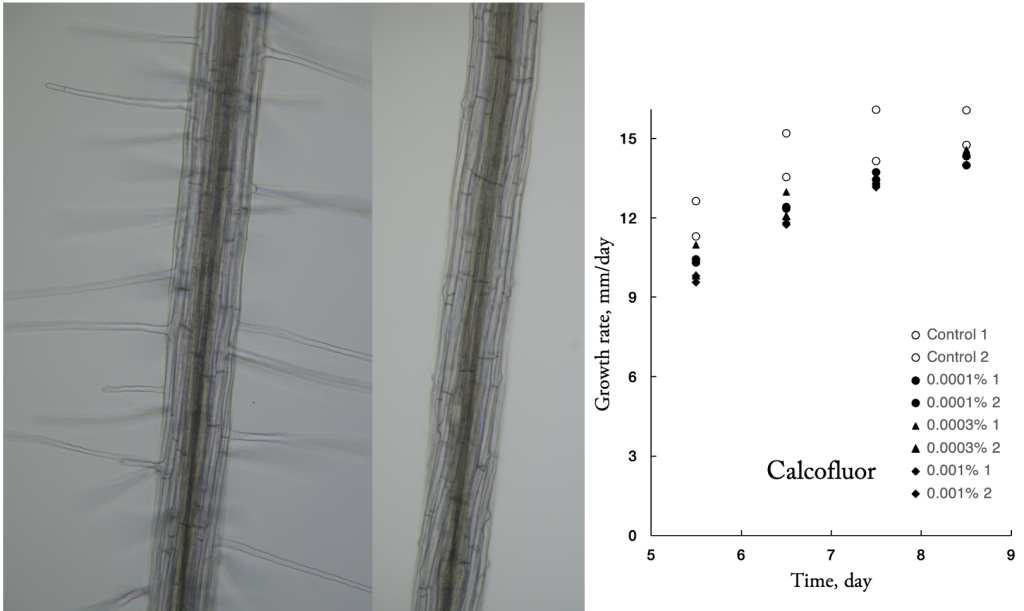At least one rabbit anyway. About a month ago, I wrote about falling down a hole chasing not a rabbits but root hairs. In efforts to coax fast scarlet into staining roots uniformly, I incorporated the dye into the agar medium, inside of which the roots grow. Alas, giving the roots continuous exposure failed to improve staining. But the dye stopped the epidermal cells that are meant to build a root hair from forming anything more than a bulge.

Figure 1. The cellulose-binding dye, Calcofluor white, inhibits root hair formation almost totally and growth maybe just a little. Left: wild type root. Center: root treated with 0.0001% (aka 1 mg/L) Calcofluor white from germination onward. Images in left and center are at the same magnification; root diameter is about 125 µm. Right: Root growth rate over time. Each symbol plots the mean for about 18 roots on a plate. Two plates per treatment (1, 2). Standard deviations are around 1 mm/day.
As a comparison, I tried another cellulose-binding dye, Calcofluor white. To my surprise, this dye too blocked root hair formation (Fig. 1, left and center). I tried three concentrations: 0.001%, 0.0003%, and 0.0001% (OK, sorry about all the zeros: those are 10, 3, and 1 mg/L, respectively). Even the lowest one I tried (pictured) was fully effective. I looked at ~ten roots on each of two plates and there were a few small root hairs here and there but similarly so for all three concentrations. I didn’t count hairs because I am not *that* keen on rabbit stew. The more or less complete inhibition of root hair formation at 1 mg/L makes Calcofluor more effective than fast scarlet (on weight per volume basis) because at 1 mg/L fast scarlet slowed root hair elongation without blocking their formation.
Along with stopping root hairs, Calcofluor tended to inhibit root elongation (Fig. 1, right). By contrast, root elongation tended to be stimulated by fast scarlet (Fig. 1 of a previous post). Nevertheless, compared to the hammering of root hair formation, these changes to the elongation of the root body are small and possibly not even reproducible.
I get hare in my nostrils from sniffing around for mechanism. Why might a cellulose-binding dye inhibit root hair formation? A scarecrow would argue because they inhibit cellulose synthesis. Certainly the dyes bind to the surface of cellulose microfibrils. Conceivably, plastering the surface of the microfibril with a dye could disrupt synthesis, particularly if the dye molecules bind to cellulose before it has had a chance to fully crystalize.
I consider this argument made of straw because of what happens when roots grow in the presence of bona fide inhibitors of cellulose synthesis. One thing that happens is that the roots swell because, without enough cellulose, the cells lose the capacity to expand faster in length than in girth, and hence root diameter doubles or even triples (the swelling in question). When I grew roots on fast scarlet at a concentration of 100 mg/L, roots maintained their diameter as usual (no swelling), although they did elongate more slowly. But also, when roots are exposed to inhibitors of cellulose synthesis, root hairs form and elongate without any trouble (for example, Fig. 2). Thus, the cellulose staining dyes appear to be specific to root hairs.

Figure 2. A root exposed to the cellulose synthesis inhibitor, dichlorobenzyl-nitrile (DCB). Plenty of root hairs grow out. The diameter of the root is ~three times that of an untreated root. Image from Figure 5 in Baskin and Bivens, 1995 Planta 197: 514 – 521.
Well, our scarecrow might splutter from the cornfield, root hairs use a somewhat different enzyme to synthesize cellulose compared to the enzymes used by the rest of the root. In making root hairs, cellulose is supposed to appear somewhat late in the process, reinforcing the newly established tubular shape of the hair. If so, then inhibiting cellulose synthesis would lead to misshapen and even lysed hairs, but would not stop things cold at the stage of the gentlest bulge (Fig. 1).
That’s a reasonable objection and yet the scarecrow could be right. When I first got root hair inhibition from fast scarlet, I thought that the explanation had to be that the dye, being taken up into the cells, was interfering with the machinery for root hair development. I could see the stained cytoplasm of root hair precursors (but not adjacent cell files) and I was impressed by the similarly blocked root hairs of a mutant called buzz, which knocks out a kinase of otherwise unknown function. However, this idea runs into trouble from Calcofluor. Chemically these two dyes are chalk and cheese. Well, I suppose they both must share a surface complementary to some facet of the cellulose microfibril lattice; but that they both also bind to some cellular kinase seems pretty straw-ful. The rabbit in title is the idea that these dyes are revealing something about the relationship between cellulose synthesis and root hair development. Perhaps the existence of an exquisitely sensitive pathway for cell wall integrity?
I am like the odor enough to keep sniffing. I want to see whether higher concentrations of Calcofluor cause root swelling. And I want to repeat the fast scarlet experiment where at a high concentration I saw protuberant bulges, more closely matching those made by buzz than the more strongly inhibited wee wrinkles seen at lower concentrations. Just in case, this time, I’ll have the camera ready.